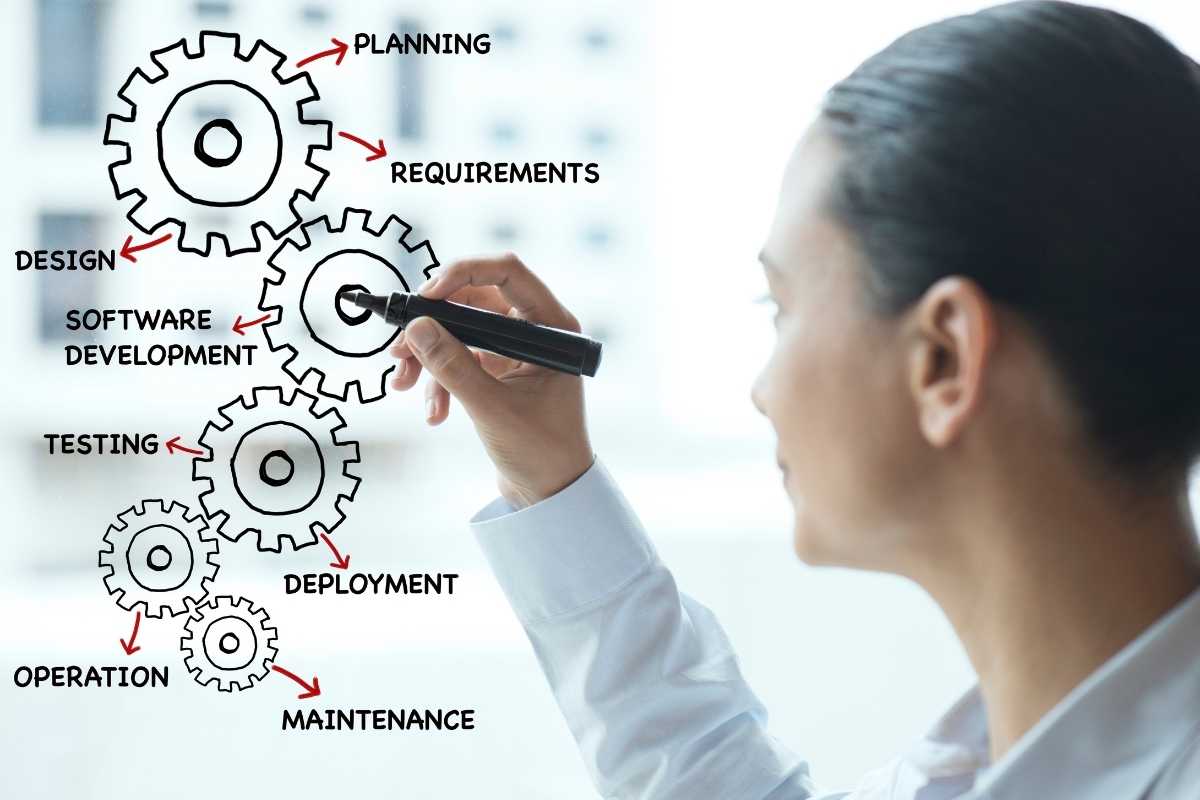Software applications and systems can transform industries. In medicine, new health apps and EMR systems updated patient scheduling systems and tracked health management. In farming, apps like Agrolly help rural farmers by predicting weather and providing connections with specialists.
Many of the current applications and systems implemented throughout major industries have needed to implement certain measures to ensure the software’s quality and performance. Many developers need to know the software development life cycle (SDLC) to create high-quality software. It not only ensures that software has been tested and perfected, but that costs and production have been lowered for successful implementation.
What is the Software Development Life Cycle?
The SDLC is a process that allows developers to create high-quality software through a series of (usually) 6 steps: planning, designing, developing, testing, deployment, and evaluation. Each step reinforces that the software is fully-fledged out and perfected. It also keeps developers from repeating work or rushing through the creation of the software.
Several software methodologies can be used to implement the stages of the SDLC. Three of the most popular processes are Waterfall, Agile, and Scrum methodologies. These methodologies will typically prioritize certain stages of the process over others depending on a customer’s wants and needs.
Stages of the Software Development Life Cycle
Planning.
The planning stage is the first and perhaps the most important step of the SDLC. It allows developers to channel all their creativity into a practical lens by asking tough questions and testing whether an idea can become a new software application or system.
The planning stage usually involves a set of parameters set in place by a customer. For example, financial costs, scheduling, and expert opinions are a few notable areas that will be discussed and clarified during this time. Challenges and potential risks will also be checked during this time.
In short, the planning stage must answer, “How is this going to work?” and provide clear guidelines of how the goal of a project will be met.
Designing.
The designing stage allows for developers to begin working and designing the more technical features of a project using the set parameters that were finalized in the first stage. This stage may involve creating prototypes or defining what needs to be developed to complete the project.
This stage also may involve checking costs and resource availability. Since the software hasn’t been built yet, there is time to sift through alternative solutions or perhaps make changes in design that can work for both the developers working on the project and the customer.
Developing.
Now that the groundwork has been laid out, developers can get to work on the physical project. The developing stage primarily involves coding and also tests a developer’s skill. Application software developers will usually need to know Java, SQL, or Python programming languages.
At this stage, teams of developers will work together to help execute the project. If one individual does not know how to do something, they can get help from another. A computer and information systems manager may be in charge of leading the team and keeping tabs on scheduling and operating costs. Meanwhile, a systems software developer will need to know C++, C, and Linux.
Testing.
The testing stage is an important step since it aims to fix any errors that are in the software. The software is tested to make sure that the product produces the correct output and that it works quickly and efficiently. This stage ensures that the application or system performs at its best capacity.
Typically, to move onto the next stage, the customer must be satisfied with the results. This stage may take longer than some of the previous steps, however, as in-depth testing is vital to making sure that the product wasn’t rushed.
Deployment.
At this point, the software has been launched and is available for all users. Developers can celebrate their work as marketing strategies are implemented so that users will know about, and want to use, the application or software.
Installation and activation need to be on point and any errors need to be fixed promptly.
Evaluation.
Once the software has been released, the performance of the application or software will be tracked and analyzed over time. If there need to be improvements implemented, then developers will make changes and updates will be launched.
Depending on the methodology implemented, this stage may be key to performance. For instance, under agile development, developers will quickly work through all the stages and use the evaluation stage to provide updates that improve the performance of the app or system.
Why is the Software Development Life Cycle Important?
The software development life cycle is important because it allows developers to have a clear process during a project. Part of the excitement of being a developer is knowing that your work will make a difference. However, just like any project, you can’t be done until it’s complete.
If it doesn’t work or can only work for the short term, then the application or system has a flaw. The SDLC detects flaws early on so that their project can be completed on time and provides the best result possible.
Software development training curriculum powered by Woz U supports anyone looking to launch their development career. Wherever you are, as long as you have an Internet connection you can readily benefit from these programs provided by our learning delivery partners.

Sophia Acevedo
Sophia Acevedo is a journalist based in Southern California. She is a 2020 graduate from California State University, Fullerton, and a proud Daily Titan alum.





